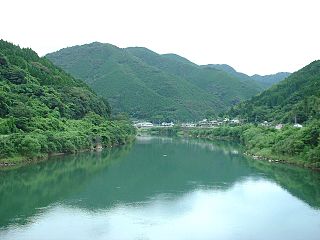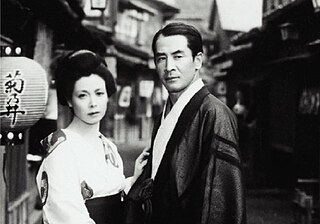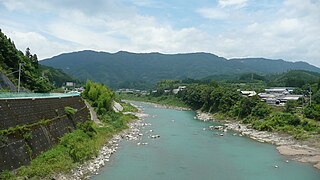
Ibaraki Prefecture is a prefecture of Japan located in the Kantō region of Honshu. Ibaraki Prefecture has a population of 2,871,199 and has a geographic area of 6,097.19 square kilometres. Ibaraki Prefecture borders Fukushima Prefecture to the north, Tochigi Prefecture to the northwest, Saitama Prefecture to the southwest, Chiba Prefecture to the south, and the Pacific Ocean to the east.

Hatoyama is a town located in Saitama Prefecture, in the central Kantō region of Japan. As of 1 March 2021, the town had an estimated population of 13,414 in 6006 households and a population density of 520 persons per km2. The total area of the town is 25.73 square kilometres (9.93 sq mi). The JAXA Earth Observation Center is located in Hatoyama.

The Shinano River, known as the Chikuma River in its upper reaches, is the longest and widest river in Japan and the third largest by basin area. It is located in northeastern Honshu, rising in the Japanese Alps and flowing generally northeast through Nagano and Niigata Prefectures before emptying into the Sea of Japan.

The Kuma River is a river in Kumamoto Prefecture, central Western part of Kyūshū, Japan. It is sometimes referred as Kumagawa River. It is the longest river in Kyushu, with the length of 115 km long and has a drainage area of 1,880 km2 (730 sq mi). The tidal flat of the Kuma River estuary is approximately 1000 hectares.

Hinokio (ヒノキオ) is a 2005 Japanese science fiction film directed by Takahiko Akiyama and starring Masatoshi Nakamura, Kanata Hongo and Mikako Tabe. Its tagline is "Inter Galactic Love".

Bōken Shōnen (冒険少年) is a manga series of short stories by Mitsuru Adachi which appeared about once a year in Shogakukan's Big Comic Original between 1998 and 2006. The title translates to "Adventure Boys." All seven stories deal with grown men, each dealing with some aspect of his past. Some of the stories have slight fantasy elements to them, while others use flashbacks. The only common feature is a grown-up protagonist somehow coming face-to-face with his childhood past, in a testament to the loss of youth, the disillusionment of growing old, and nostalgia for better times. In the Adachi pantheon, this is a rare diametric view of his eternal theme of "youth," in this case youth as seen through the lens of the past.
Torii Tadanori was a Japanese daimyō of the early Edo period who ruled the Takatō Domain in Shinano Province. Tadanori was the son of Torii Tadaharu, the previous lord. He succeeded to family headship upon his father's death; however, he continued his father's draconian rule of the Takatō domain. During the shogunate's investigation into a scandal involving Takatō retainer Takasaka Gonbei, Tadanori was ordered confined to his residence in Edo; he died during his confinement. The Takatō domain was confiscated from the Torii family; however, as the Torii family was a famed fudai family dating back to Torii Mototada, Tadanori's heir Tadateru was granted four districts in Noto Province, and made the lord of the Shimomura Domain.
The Fujisankei Classic is a professional golf tournament on the Japan Golf Tour. It was first played in 1973 at the Takasaka Country Club. The tournament moved to the Higashi-Matsuyama Golf Club in 1979 and to the Kawana Hotel's Fuji course in 1981. The tournament has been held at the Fujizakura Country Club in Yamanashi Prefecture since 2005. The prize fund in 2019 was ¥110,000,000, with ¥22,000,000 going to the winner. The title sponsor is the Fujisankei Communications Group.

The Shō River has its source in Mount Eboshi in the Shōkawa-chō area of Takayama, Gifu Prefecture, Japan. After flowing for 115 km (71 mi) through the northern part of Gifu Prefecture and the western part of Toyama Prefecture, it empties into Toyama Bay.

Higashi-Matsuyama Station is a passenger railway station located in the city of Higashimatsuyama, Saitama, Japan, operated by the private railway operator Tōbu Railway.

Kita-Sakado Station is a passenger railway station located in the city of Sakado, Saitama, Japan, operated by the private railway operator Tōbu Railway.

Takasaka Station is a passenger railway station located in the city of Higashimatsuyama, Saitama, Japan, operated by the private railway operator Tōbu Railway.

An Inlet of Muddy Water is a 1953 Japanese drama film based on short stories by Ichiyō Higuchi and directed by Tadashi Imai. It was entered into the 1954 Cannes Film Festival and awarded numerous national film prizes.

DHC Ladies Bowling Tour (DHCレディースオープンボウリングツアー) was a Japan-based bowling tour for women bowlers. The Tour hosted a series of four to five tournaments each year throughout Japan. The tournaments were open to both professionals and amateurs. The Tour's corporate sponsor was DHC Corporation, a maker of cosmetics and health food supplements. The CEO of DHC is Yoshiaki Yoshida - one of the biggest supporters of the sport of bowling in Japan. DHC LBT started up in 2005, and was sanctioned by the Japan Professional Bowling Association (JPBA).
Niikappu River is a river in Hokkaidō, Japan.

The Gōnokawa River is a river that runs through Hiroshima and Shimane prefectures in Japan. It is the largest river in the Chūgoku region. It is also called the Gōgawa River and, in Hiroshima, the Enokawa River.

Mimi River is a river of Japan. It flows through the Miyazaki Prefecture. There is cascade of six dams built on the river with two dams in the upstream basin of the Tsukabaru Dam and three dams on the downstream.

The Shin-Takasegawa Pumped Storage Station (新高瀬川発電所) uses the Takase River to operate a pumped storage hydroelectric scheme about 12 kilometres (7.5 mi) west of Ōmachi in Nagano Prefecture, Japan. Part of the system is within Chūbu-Sangaku National Park.

Tokoname ware is a type of Japanese pottery, stoneware, and ceramics produced in and around the municipality of Tokoname, Aichi, in central Japan. Tokoname was the location of one of the Six Ancient Kilns of Japan.
















